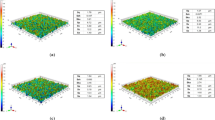Abstract
The oblique cutting process has been extensively studied in the past, and was shown to be a better representative of many practical machining operations than orthogonal cutting. In this paper, an existing conventional mechanics of cutting approach to forces and power, as a direct modelling methods for performance prediction, is discussed. The number of process variables required for this process of performance prediction are highlighted, and the limitations of the model are shown. A neural network architecture is developed for use as a direct modelling method, to predict forces and power in a single-edged oblique cutting operation. Oblique cutting experiments covering a comprehensive range of tool geometrical features were carried out to verify the predictive nature of both the traditional and neural network models. The quantitative predictive capability of using traditional and neural network approaches are compared using statistical routines, which showed that neural network predictions for three force components were ± 3% close to the experimental values, compared to ± 15% using conventional methods.
Similar content being viewed by others
Author information
Authors and Affiliations
Rights and permissions
About this article
Cite this article
Karri, V. Performance in Oblique Cutting using Conventional Methods and Neural Networks. Neural Comput & Applic 8, 196–205 (1999). https://doi.org/10.1007/s005210050022
Published:
Issue Date:
DOI: https://doi.org/10.1007/s005210050022




